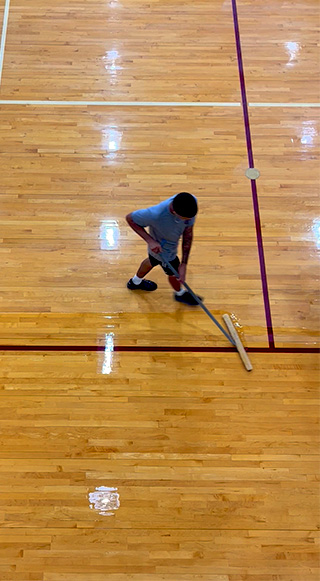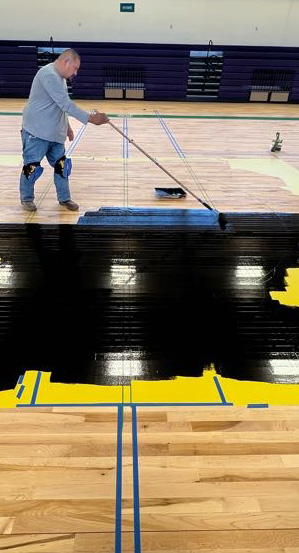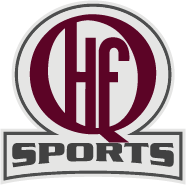Next to cost, a projects lead time to "ready for play" can affect how and when to service your gym floors. An unusable facility causes certain headaches such as event rescheduling and lost revenue. QHF Sports (QHF) works efficiently to return your team to the gym floor safely and on-schedule for all of your upcoming events.
This is our business after all; to get your players back on the hardwood. Thus, our pros understand that the most pressing question (perhaps more important than cost) is: "When can we get back on the floor"? Luckily we have some answers. Let's break down and explain QHF Sports' core service windows.


Annual Refinishing
Return To Play: 4 Days
The refinishing process consists of removing unsightly marks and adding a new layer of sports finish. The new gym floor finish requires 72 hours to fully cure. So QHF recommends 3 days before using the floor. Failing to allow the finish to cure, uncovered, for these crucial 72 hours can result in scuff marks and uneven, thus unsafe, playing surface.
The Maple Flooring Manufacturers Association (MFMA) recommends “recreational surfaces receive periodic refinishing. Facility use and maintenance will determine the appropriate refinishing schedule. Most gymnasium floors should be annually recoated". We routinely maintain our vehicles and our bodies (if not, you need to examine some life choices), so why wouldn't we want to maintain our expensive hardwood floors?
Sand | Paint | Refinish
Return To Play: 2 Weeks
Every once in a while, even the most cared for hardwood floor will require what QHF calls a “sand-down”. Resurfacing a gym's hardwood can return an older gym surface to “like-new” conditions and improve performance.
The sanding process removes existing finish and game-lines resulting in bare-wood. This allows QHF to inspect the gym floor for any damaged boards or areas on the playing surface and subfloor. Next the gym floor is lightly sanded again to ensure removal of all minor dents or scratches. Generally the sanding process can take 3 days for a full-court sanding. After sanding, the seal/paint/finish process can look like this:
- Sealing: Recommend 2 days to cure
- Painting: 1 full day per color*
- Finish Application: 3 days to cure
Unless tragedy strikes (more about this below), you'll want to sand your gym floor down to bare wood every 8-12 years. Barring any major disasters, the MFMA recommends no more than 6 total sand-downs for the approximate 75-year lifetime of a gym floor.
*The majority of courts will have multiple colors. Paint dry-time adds up when you have adjacent, or touching, colors as one would in a multi-color logo. Thus, if colors are not touching, like game markings, QHF can paint those at the same time.


Gym Floor Repairs
Return To Play: Dependant On Extent Of Damage
We don’t like giving "it depends" as an answer any more than you like hearing it. However, to provide an accurate "return to play" window on repairs, QHF needs to assess the extent of the damage. Hardwood horrors such as water-damage, heavy equipment, irregular maintenance and heavy wear-and-tear can wreak havoc on hardwood sports floors.
This damage can affect both small and large areas of your gym floor depending on the type and extent. "Gym floor repair" is a broad term and can entail a number of things. However, typical damage to your gym floor will lead to removal of damaged sections (hopefully not the entire court). Once replaced, the new floor will follow the above sand/paint/finish process listed above to match** existing, unaffected gym floor.
**Spot-repairs can result in a difference of appearance to the undamaged areas. QHF takes great care to match existing game markings and appearance. Customers should be aware that variables like age and color-matching can affect how close we can match the existing floor.

Gym Floor Water Damage: Explained - Quality Hardwood Floors
September 29, 2021
[…] Gym floor professionals will reinstall subfloor systems and replace floor boards after ensuring proper humidity levels. New boards will be staggered into place to hide the repair lines that were cut out. Then the floor will be sanded, painted and finished to closely match the existing floor. Quality Hardwood Floors aims to return water-damaged gyms quickly so your gym floor is safe and athletes can return to play. […]
Gym Floor Water Damage: Explained - QHF Sports
November 27, 2023
[…] After ensuring proper concrete slab moisture levels gym floor professionals can reinstall subfloor systems. New maple will cover replaced subflooring. Then QHF will sand, paint and finish floors to closely match the existing floor. Quality Hardwood Floors aims to return water-damaged gyms quickly. As always, our aim is to ensure your gym floor is safe for athletes. […]